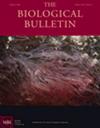Monogamy in the Burrowing Shrimp Axianassa australis Rodrigues & Shimizu, 1992 (Decapoda, Gebiidea, Axianassidae)
IF 1.9
4区 生物学
Q2 BIOLOGY
引用次数: 2
Abstract
Our knowledge of the mating systems in burrowing shrimps (infraorders Axiidea and Gebiidea) is still rather limited. Here we describe the burrow use pattern, sex ratio, and sexual dimorphism of the burrowing shrimp Axianassa australis to test for monogamy, considering that monogamous species live in heterosexual pairs and exhibit a low degree of sexual dimorphism. To this end, a total of 226 individuals of A. australis were collected from the northeast region of Brazil. Our results showed that A. australis inhabited its burrows mainly as pairs, most of which were male-female pairs. In agreement with the expectations, specimens of A. australis were found dwelling as heterosexual pairs more frequently than expected by chance alone. The presence of ovigerous females was associated with the burrow occupation; that is, brooding females were more frequently observed in male-female combinations than solitarily. Also supporting theoretical considerations, we did not observe sexual dimorphism in body size between males and females of the population and the different categories of the burrow occupation. Conversely, sexual dimorphism in cheliped size was evident in the population, with larger chelipeds in males than in females. This observation agrees with that reported for most burrowing shrimps in which male-male competition is the main evolutionary force of sexual selection. The observations above favor the hypothesis that A. australis is primarily monogamous, with a small fraction of the males moderately promiscuous.穴虾的一夫一妻制(十足目,虾总科,穴虾科)
我们对穴居虾的交配系统(下目,轴目和格目)的了解仍然相当有限。考虑到一夫一妻制的物种生活在异性伴侣中,并且表现出低程度的性别二态性,本文描述了穴居虾的洞穴使用模式、性别比例和性别二态性,以测试一夫一妻制。为此,在巴西东北部地区共采集了226只南斑蝽。结果表明,南方古猿穴居以雌雄配对为主,以雌雄配对居多。与预期一致的是,南方南方古猿以异性伴侣的方式生活的频率比仅仅偶然发现的要高。雌雄同体的存在与洞穴占领有关;也就是说,雌性在雄性和雌性组合中比单独交配时更常被观察到。同样支持理论考虑的是,我们没有观察到种群中雄性和雌性在体型和穴居的不同类别之间的性别二态性。相反,在种群中,性别二态性在脚肢大小上是明显的,雄性的脚肢比雌性的脚肢大。这一观察结果与大多数穴居虾的研究结果一致,在穴居虾中,雄性之间的竞争是性选择的主要进化力量。上述观察结果支持南方古猿主要是一夫一妻制的假设,只有一小部分雄性适度滥交。
本文章由计算机程序翻译,如有差异,请以英文原文为准。
求助全文
约1分钟内获得全文
求助全文
来源期刊

Biological Bulletin
生物-海洋与淡水生物学
CiteScore
3.30
自引率
6.20%
发文量
47
审稿时长
6-12 weeks
期刊介绍:
The Biological Bulletin disseminates novel scientific results in broadly related fields of biology in keeping with more than 100 years of a tradition of excellence. The Bulletin publishes outstanding original research with an overarching goal of explaining how organisms develop, function, and evolve in their natural environments. To that end, the journal publishes papers in the fields of Neurobiology and Behavior, Physiology and Biomechanics, Ecology and Evolution, Development and Reproduction, Cell Biology, Symbiosis and Systematics. The Bulletin emphasizes basic research on marine model systems but includes articles of an interdisciplinary nature when appropriate.
 求助内容:
求助内容: 应助结果提醒方式:
应助结果提醒方式:


